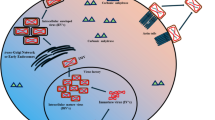Abstract
An interspecies conservedPlasmodium asparagine rich antigen, designated as ARK26, was isolated by immunoscreeningP. falciparum genomic DNA expression library with mouse convalescent anti-P. yeolii serum. Partial DNA sequence analysis reveals that ARK26 contains clusters of asparagines and no randomly repeated amino acid sequence motifs are observed. A 65×103 GST fusion protein is expressed by recombinant plasmid PGEX-5X-1 (ARK26) inE. coli C strain ABLE-K. Computer programs predict that two asparagine rich regions are among the possible antigenic epitopes of p37 encoded by ARK26. Interestingly, the sequence of ARK26 displays significant similarity to yeast and several other species’ mitochondrial genes, and its possible function is discussed.
Similar content being viewed by others
Abbreviations
- GST:
-
glutathione-S-Transferase
- CSP:
-
circumsporozoite protein
- kb:
-
kilobase pairs
- IPTG:
-
isopropyl-β-D-thiogalactoside
- NCBI:
-
National Center of Biotechnology Information
- PHD:
-
prediction program of protein secondary structure
- HEPES:
-
N-2-hydroxyethylpiperazine-N′-2-ethanesulfonic acid
- IFAT:
-
Immunofluorescent Antibody Test
- ACRs:
-
Ancient Conserved Regions
- CARP:
-
clustered-asparagine-rich protein
- Asn:
-
asparagine
References
Francis E G. Malaria vaccines-progress and problems.Trend in Biotechnology, 1991,9(11):389–394
Ray P, Sahoo N, Singh B,et al. Serum antibody immunoglobulin G of mice convalescent fromPlasmodium yeolii infection inhibits growth ofPlasmodium falciparum in vitro: Blood stage antigens ofP. falciparum involved in interspecies cross-reactive inhibition of parasite growth.Infect Immun, 1994,62: 2354–2361
Cerami C, Frevert U, Sinnis P,et al. The basolateral domain of the hepatocyte plasma membrane bears receptors for the circumsporoite protein ofPlasmodium falciparum sporozoites.Cell, 1992,70(6):1021–1033
Chauhan V S, Chatterjee S, Johar P K. Synthetic peptides based on conservedPlasmodium falciparum antigens are immunogenic and protective againstPlasmodium yeolii malaria.Parasite Immunol, 1993,15:239–242
Wahlgren M, Aslund L, Franzen L,et al. A Plasmodium falciparum antigen containing clusters of asparagine residues.Proc Natl Acad Sci, 1986,83(8):2677–2681
Ardeshir F, Howard R E, Viriyakosol S,et al. Crossreactive asparagine-rich determinants shared between several blood-stage antigens ofPlasmodium falciparum and the circumsporoite protein.Mol Biochem Parasitol, 1990,40:113–128
Caveller L, Sjolander A, Aslund L,et al. ThePlasmodium falciparum clustered-asparagine-rich protein is a malaria vaccine candidate.Vaccines, 1991,91:375–379
Kironde F A S, Kumar A, Nayak A R,et al. Antibody recognition and isoelectrofocusing of antigens of the malaria parasitePlasmodium yeolii.Infect Immun, 1991,59:3909–3916
Trager W, Jensen J B. Human malaria parasites in continuous culture.Science, 1976,193(4254):673–675
Lambros C, Vanderberg J P. Synchronization ofPlasmodium falciparum erythrocytic stages in culture.J Parasitol, 1979,65:418–420
Ma D, Ma H, Shen P,et al. Cloning and expression of interspecies conserved antigen ofPlasmodium flaciparum.J Wuhan Univ (Nat Sci Ed), 1996, 42 (Special Issue on Biotechnology Suppl):85–90 (in Chinese)
Sambrook J, Fritsch E F, Maniatis T.Molecular cloning: A Laboratory Manual. Cold Spring Harbor Laborator Press, 1989
Sanger F, Nicklen S, Coulson A R. DNA sequencing with chain terminating inhibitors.Proc Natl Acad Sci, 1977,74(12):5463–5467
Altschul S F, Gish W, Miller W. Basic local alignment search tool.J Mol Biol, 1990,215(3):403–410
Rost B, Sander C. Bridging the protein sequence-structure gap by structure predictions.Annu Rev Biophys Biomol Struct, 1996,25(1):113–136
Weber J L. Analysis of sequences from the extremely A+T-rich genome ofPlasmodium falciparum.Gene, 1987,52(1):103–109
Bairoch A, Bucher P, Hofmann K. The PROSITE database, its status in 1995.Nucleic Acids Res, 1996,24(1):189–196
Hopp T P, Woods K R. Prediction of protein antigenic determinants from amino acid sequences.Proc Natl Acad Sci, 1981,78(6):3824–3828
Koonin E V, Tatusov R L, Rudd K E. Sequence similarity analysis of Escherichia coli proteins: functional and evolutionary implications.Proc Natl Acad Sci, 1995,92(25):11921–11925
Da Silveira F J, Sibilli L, Brunet E,et al. Cloning of cDNAs that code forPlasmodium chabaudi antigens of the erythrocytic forms and cross-hybridize withP falciparum.Mol Biochem Parasitol, 1984,11:133–143
Taylor D W, Kim K J, Munoz P A,et al. Monoclonal antibodies to stage-specific, species-specific, and crossreactive antigens of the rodent malaria parasite,Plasmodium yeolii.Infect Immun, 1981,32:563–570
Stahl H D, Bianco A E, Crewther P E,et al. An asparagine-rich protein from blood stages ofPlasmodium falciparum shares determinants with sporozoites.Nucleic Acids Res, 1986,14(7):3089–3102
Barale J C, Attal-Bonnefoy G, Brahimi K,et al. Plasmodium falciparum asparagine and aspartate rich protein 2 is an evolutionary conserved protein whose repeats identify a new family of parasite antigens.Mol Biochem Parasitol, 1997,87:169–181
Barale J C, Candelle D, Attal-Bonnefoy G,et al. Plasmodium falciparum AARP1, a giant protein containing repeated motifs rich in asparagine and aspartate residues, is associated with the infected erythrocyte membrane.Infect Immun, 1997,65:3003–3010
Author information
Authors and Affiliations
Additional information
Supported by a fellowship offered by International Center for Genetic Engineering & Biotechnology(ICGEB)
Ma Donghui: born in 1969, Graduate student
Rights and permissions
About this article
Cite this article
Donghui, M., Xiaojie, L., Huiwen, M. et al. An interspecies conserved antigen ofPlasmodium falciparum containing clusters of asparagine residues. Wuhan Univ. J. Nat. Sci. 3, 369–376 (1998). https://doi.org/10.1007/BF02829997
Received:
Issue Date:
DOI: https://doi.org/10.1007/BF02829997




